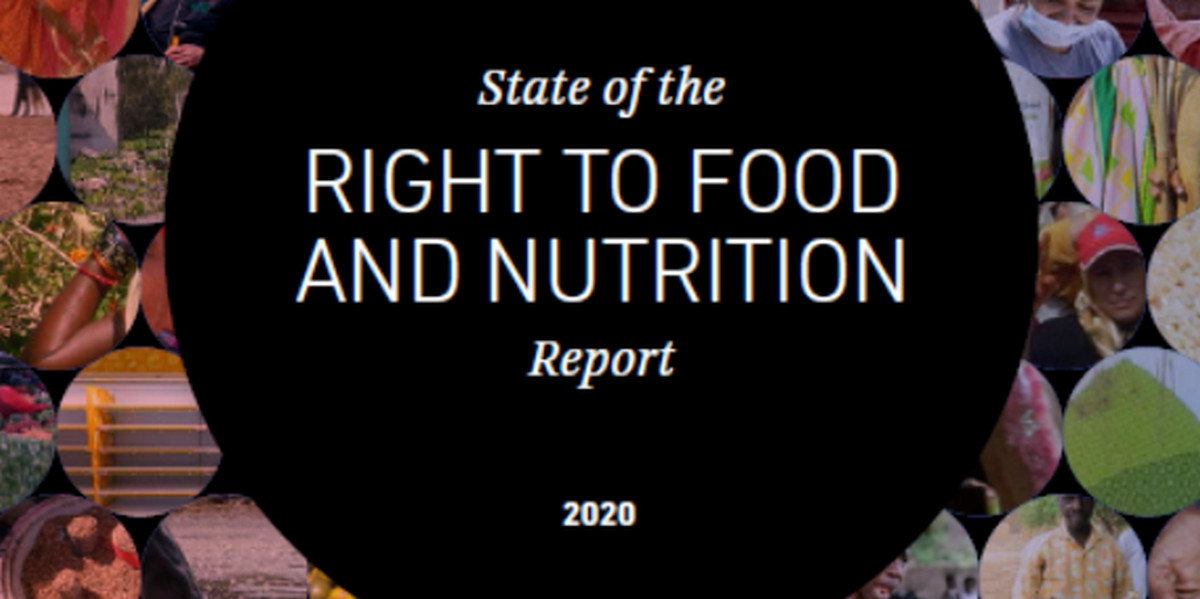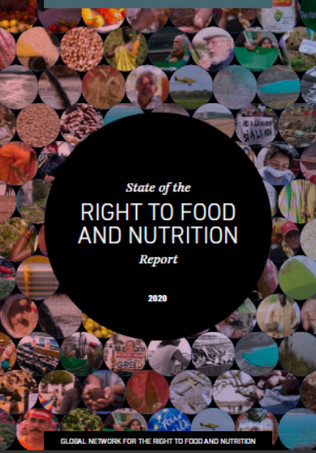Authors: Daniel Fyfe, Ayushi Kalyan, Yifang Tang, M. Alejandra Morena, Astrud Lea Beringer
A new report by the Global Network for the Right to Food and Nutrition (GNRtFN) portrays an alternative story of hunger
Just over a week after the publication of the UN’s State of Food Security and Nutrition (SOFI) report presenting the global hunger and food insecurity figures, the Global Network for the Right to Food and Nutrition (GNRtFN) releases its 2020 State of the Right to Food and Nutrition Report.
As in the previous edition, this issue seeks to complement SOFI using an alternative approach based on progress regarding the right to food and food sovereignty to monitor hunger and malnutrition.
“The aim is to look beyond the numbers presented by SOFI, by portraying insights from struggles on the ground across regions, a perspective too often left out from discussions on food insecurity”, explains Daniel Fyfe, monitoring coordinator of FIAN International, Secretariat of the GNRtFN.
“Communities, social movements and civil society organizations working daily on the ground are the “real experts” whose voices should be heard when monitoring the right to food and nutriton”, Fyfe continues.
This year’s report also presents how the COVID-19 pandemic has exposed decades of failed policies that cut people’s social and labour rights, leaving them at the mercy of food banks and other charities. Together with FIAN International’s COVID-19 Monitoring Reports, this issue highlights how the structural causes of hunger and malnutrition predate the COVID-19 pandemic, which will, according to SOFI, severely increase the number of hungry people, making the Zero Hunger by 2030 target of Sustainable Development Goal 2 even more difficult to attain.
Some of the developments on the right to food and nutrition highlighted in the report include:
- The outbreak of the COVID-19 disease has highlighted the intrinsic link between the predominant industrial food system, climate change, and eco-destruction. The right to food and nutrition offers a place of convergence for the agrarian and climate justice movements, and serves as a powerful tool to address the climate crisis.
- Across regions, communities and local governments are already actively transforming food systems, such as in Gaza where urban and peri-urban agriculture practices have become strategies for achieving food sovereignty in a context of protracted crisis; or in Spain’s Balearic Islands, where the local government has used its procurement policy to buy fresh food products from small-scale local food producers for food aid as well as for public school meals.
- Authoritarianism and attacks on human rights persist across regions, for instance in India, the Philippines and Malawi. Killings of human rights defenders continue to be rampant in Colombia, Mexico, Honduras and Brazil.
- On the other hand, the right to food and nutrition has been strengthened through progressive legal developments at national level, for instance in Paraguay, Honduras and Togo. At regional level, the African Commission on Human and People’s Rights adopted a resolution on the right to food and nutrition, while the Inter-American Court of Human Rights rendered a landmark decision recognizing for the first time a violation of the right to food.
- Human rights accountability at the international level continues to be weakened: The UN Office of the High Commissioner for Human Rights (OHCHR) suffered severe budgetary constraints, and civil society across the globe harshly criticized the signing of a strategic partnership agreement between the UN and the World Economic Forum as corporate capture of the UN.
“The State of the Right to Food and Nutrition Report confirms the pressing need to protect human rights”, Daniel Fyfe points out.
“In light of the current multiple crises, communities worldwide have already started organizing for the transformation of food systems which implies claiming the rights of small-scale food producers who produce most of the food we consume. More than ever, States need to urgently implement key instruments on the realization of the right to adequate food and nutrition adopted by the UN Committee on World food Security, as well as the UN Declaration on the Rights of Peasants and Other People Working in Rural Areas”, Fyfe conclude
Note: The report covers the period between July 2019 and July 2020. It does not claim to be exhaustive, but rather covers countries, regions, and cases where the GNRtFN members are active.
CIDSE is a member of the Global Network for the Right to Food and Nutrition which comprises nearly 50 civil society organizations and social movements from all corners of the globe.


